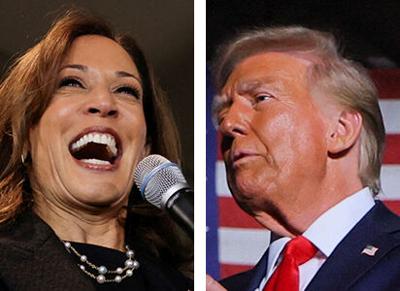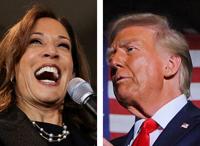Vice President Kamala Harris notched a solid victory over former President Donald Trump to win New Hampshire’s four electoral votes.
While Harris rolled up big margins in the Democratic city strongholds such as Concord, Manchester, Keene and Dover, she also defeated Trump in wealthier suburbs such as New London and Hanover in the Upper Valley and Brookline and Hollis by the Massachusetts border.
Trump defeated Harris in the city of Rochester and in the North Country city of Berlin along with more traditional GOP stronghold towns such as Jaffrey, Rindge, Belmont, Hillsborough, Deerfield and Milton.
The electoral dilemma for Trump was that he failed to roll up big enough winning margins in GOP-leaning areas to overcome Harris running up the score where she was stronger.
Some national media forecasters declared Harris the winner about an hour after the polls closed but into the night and early morning hours, Trump did narrow the lead.
Associated Press made its call at 1:15 a.m. that New Hampshire had gone to Harris.
With 89% of the vote reported by 8 a.m. Wednesday, Harris had 51% of the vote to 48% for Trump. Libertarian Party nominee Chase Oliver and Green Party candidate Jill Stein each got about one-half of 1% of the vote.
U.S. Sen. Jeanne Shaheen, D-N.H, had said she was confident that Harris was going to win because she offered a positive vision to the voters while Trump sowed division.
“He called out people to shoot the press that were standing there in his rally. He wants to deport millions of Americans; that’s the vision Donald Trump has,” Shaheen said.
“Donald Trump has said he’ll take revenge on his opponents. Kamala is talking about putting her opponents at the table so we can all work together.”
“I want a President who understands that they need to be President for all Americans.”
Republican State Chairman Chris Ager said Tuesday night his leadership made a calculated decision to urge the Trump campaign to devote its resources to the key battleground states and spend less money and time in New Hampshire.
“We said to them, ‘OK let them (Democrats) spend all their resources here and go win your race,’” Ager said.
“It was a very different campaign for President Trump than in 2015. The grassroots didn’t need to be inspired by visits from the candidate.”
Trump had been trying to win the state in his third presidential bid.
In his 2016 victory nationally, Trump lost here to Democratic nominee and former Secretary of State Hillary Clinton by 2,742 votes or less than one-half of 1%.
Trump had beat Clinton in six of 10 counties, but the Democrat prevailed because of her huge margin of victory in the Upper Valley and along the Connecticut River Valley in the western part of the state.
Four years later, Biden defeated Trump convincingly by 7% of the vote or more than 59,000 ballots.
The only counties Trump won in that race were by a narrow margin in northernmost Coos County and in Belknap County in the Lakes Region.
Throughout the frenzied presidential election elsewhere in the country, Trump consistently trailed his Democratic opponent in New Hampshire, which followed one of the most bizarre presidential primary cycles in state history.
In November 2022, the Democratic National Committee, at the behest of President Joe Biden, approved a presidential primary calendar that tried to award South Carolina with the first primary.
Back in 2020, Biden finished fifth in the Granite State primary, and it was South Carolina a few weeks later that resurrected his candidacy and put him on the glidepath to the presidential nomination.
The DNC offered New Hampshire to share the second contest date with Nevada but only if lawmakers repealed New Hampshire’s first-in-the-nation primary law and also adopted no-excuse absentee ballot voting.
Republican Gov. Chris Sununu called the moves “political blackmail” and bipartisan leaders in the Legislature and the state’s all-Democratic congressional delegation supported Secretary of State David Scanlan’s decision to schedule the primary in late January ahead of all other states.
In response, Biden refused to file his candidacy or campaign in New Hampshire during the primary.
Despite that, a grassroots organization led by Democratic operatives engineered the largest write-in primary vote for Biden in state history. He defeated Minnesota U.S. Rep. Dean Phillips by better than a 3-1 margin.
In the GOP primary, Trump returned to campaign in New Hampshire at large rallies half a dozen times in the runup to the vote.
Despite his refusal to engage in debates with his GOP rivals, one after another potential challenger to Trump dropped out in the weeks leading up to New Hampshire’s vote.
The only major contender left standing was former South Carolina Gov. Nikki Haley who had the enthusiastic support of popular GOP Gov. Sununu.
Trump managed to win New Hampshire by double digits, 56% to 44%, which helped the former president wrap up the nomination after beating Haley decisively in her home state a few weeks later.
In the fall campaign, Trump chose not to return to New Hampshire after his primary win, instead spent nearly all of his time in the seven battleground states that leaders of both campaigns agreed would likely decide this election.
He did dispatch his running mate, Sen. JD Vance, R-Ohio, during the final weekend.
Ager noted the Trump team was able to attract massive convoys of car and truck owners showing up during several weekends this summer and fall.
“This campaign has had a level of organic energy greater than I’ve ever seen before,” Ager said.
Even though Biden didn’t compete here, the DNC decided to devote millions of dollars here to set up one of its largest field organizations in recent memory.
Democratic Party Chairman Ray Buckley led the effort to set up 18 coordinated campaign offices across the state with more than 120 paid staffers.
“This ground game could make all the difference in a close election; that’s what we are banking on,” Buckley said prior to the outcome.
Biden visited the state twice before he abruptly decided to withdraw from the race after a poor performance during his only debate with Trump.
A month after Harris officially became the replacement nominee at the Democratic National Convention, she made a stop at the North Hampton brewery where she outlined her plan to dramatically increase tax deductions for the owner of a new small business.
Harris’s running mate, Minnesota Gov. Tim Walz, had visited the state twice earlier in the year as the former chairman of the Democratic Governors Association.
Over the final six weeks of the campaign, a steady stream of other surrogates came to stump on behalf of the Harris/Walz ticket including two-time New Hampshire primary winner and Vermont independent Sen. Bernie Sanders, California Gov. Gavin Newsom, Pennsylvania Gov. Josh Shapiro and Kentucky Gov. Andy Beshear.
A few weeks before the vote, Biden returned one final time for an official, taxpayer-paid visit to the state to talk about his work to lower the cost of prescription drugs.
Biden then attended a reception at state party headquarters where he called for Trump to be “locked up.” After a four-second pause, Biden said he had meant to say Trump should be “locked out” from winning the White House.
Though the Granite State remains a purple or swing states for many contested offices, then-candidate George W. Bush was the last Republican to narrowly win New Hampshire in 2000.
Bush’s win over then-Democratic Vice President Al Gore and the state’s four electoral votes were the margin of victory in the Electoral College.
Then, four years later, Bush narrowly lost New Hampshire by 1.4% to former Massachusetts U.S. Sen. John F. Kerry and Democrats have been winning the state ever since.






